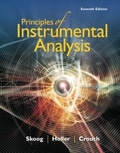
(a)
Interpretation:
The relative error in the voltage reading if the internal resistance of the voltmeter was 4000 χ should be calculated.
Concept introduction:
The percentage relative loading error of the voltmeter Er =
VM = Voltage of the meter
VX = True voltage of the source
When resistors are in series, a voltage divider. V = V1 + V2 + V3
The current in a series circuit is everywhere the same. In other words, I = I1 = I2 = I3
The total resistance Rs of a series circuit is equal to the sum of the resistances of the individual components. Rs = R1 + R2 + R3
Ohm’s law;
Ohm’s law describes the relationship among voltage, resistance, and current in a resistive series circuit.
V = IR
V = Voltage I = Current R = resistant
(b)
Interpretation:
The relative error in the voltage reading if the internal resistance of the voltmeter was 80.0 kχ should be calculated.
Concept introduction:
The percentage relative loading error of the voltmeter E r =
VM = Voltage of the meter
VX = True voltage of the source
When resistors are in series, a voltage divider. V = V1 + V2 + V3
The current in a series circuit is everywhere the same. In other words, I = I1 = I2 = I3
The total resistance Rs of a series circuit is equal to the sum of the resistances of the individual components. Rs = R1 + R2 + R3
Ohm’s law;
Ohm’s law describes the relationship among voltage, resistance, and current in a resistive series circuit.
V = IR
V = Voltage I = Current R = resistant
(c)
Interpretation:
The relative error in the voltage reading if the internal resistance of the voltmeter was 1.00 Mχ should be calculated.
Concept introduction:
The percentage relative loading error of the voltmeter E r =
VM = Voltage of the meter
VX = True voltage of the source
When resistors are in series, a voltage divider. V = V1 + V2 + V3
The current in a series circuit is everywhere the same. In other words, I = I1 = I2 = I3
The total resistance Rs of a series circuit is equal to the sum of the resistances of the individual components. Rs = R1 + R2 + R3
Ohm’s law;
Ohm’s law describes the relationship among voltage, resistance, and current in a resistive series circuit.
V = IR
V = Voltage I = Current R = resistant
Trending nowThis is a popular solution!

Chapter 2 Solutions
Principles of Instrumental Analysis
- Write the systematic name of each organic molecule: structure HO-C-CH2-CH3 O -OH CH3-CH2-CH2-CH2-CH2-C-OH CH3 CH3-CH-CH2-C-OH Explanation Check S namearrow_forwardtheres 2 productsarrow_forwardDraw the major product of this solvolysis reaction. Ignore any inorganic byproducts. + CH3CH2OH Drawing Q Atoms, Bonds and Rings OCH2CH3 || OEt Charges OH 00-> | Undo Reset | Br Remove Done Drag To Pan +arrow_forward
- Draw the major product of this SN1 reaction. Ignore any inorganic byproducts. CH3CO2Na CH3CO2H Drawing + Br Q Atoms, Bonds and Rings OAC Charges OH ОАс Na ဂ Br Undo Reset Remove Done Drag To Pan +arrow_forwardOrganic Functional Groups entifying positions labeled with Greek letters in acids and derivatives 1/5 ssible, replace an H atom on the a carbon of the molecule in the drawing area with a ce an H atom on the ẞ carbon with a hydroxyl group substituent. ne of the substituents can't be added for any reason, just don't add it. If neither substi er the drawing area. O H OH Oneither substituent can be added. Check D 1 Accessibility ado na witharrow_forwardDifferentiate between electrophilic and nucleophilic groups. Give examples.arrow_forward
- An aldehyde/ketone plus an alcohol gives a hemiacetal, and an excess of alcohol gives an acetal. The reaction is an equilibrium; in aldehydes, it's shifted to the right and in ketones, to the left. Explain.arrow_forwardDraw a Haworth projection or a common cyclic form of this monosaccharide: H- -OH H- OH H- -OH CH₂OHarrow_forwardAnswer the question in the first photoarrow_forward
- Ggggffg2258555426855 please don't use AI Calculate the positions at which the probability of a particle in a one-dimensional box is maximum if the particle is in the fifth energy level and in the eighth energy level.arrow_forwardExplain the concepts of hemiacetal and acetal.arrow_forwardBriefly describe a nucleophilic addition.arrow_forward
 Principles of Instrumental AnalysisChemistryISBN:9781305577213Author:Douglas A. Skoog, F. James Holler, Stanley R. CrouchPublisher:Cengage Learning
Principles of Instrumental AnalysisChemistryISBN:9781305577213Author:Douglas A. Skoog, F. James Holler, Stanley R. CrouchPublisher:Cengage Learning
